Application of color temperature knowledge in photography
If the light emitted by a light source has the same spectral components as the light emitted by a black body at a certain temperature, it is called a certain K color temperature. For example, the color of the light emitted by a 100W bulb is the same as that of an absolute black body at 2527°C, then the color temperature of the light emitted by this bulb is: (2527+273) K=2800K.
Chinese name: color temperature single digit: K(kelvin) Kelvin temperature)
English name: colo(u)r temperature Application areas: photography, video, publishing, etc.
|
contents |
1 Light source color 2 Principle 3 role |
4 Use cases 5 Color temperature positioning 6 effect |
7 Balance |
Details:
Color temperature is a temperature measurement method, usually used in the fields of physics and astronomy. This concept is based on an imaginary black object that emits different colors of light when heated to different temperatures, and its objects appear in different colors. Just like when an iron block is heated, the iron block first turns red, then yellow, and finally white.
The color temperature calibrated by this method is exactly the opposite of what the general public thinks of "warm" and "cold". For example, people usually feel red. Orange and yellow are warmer, white and blue are colder, but in fact red has the lowest color temperature, and then gradually increases are orange, yellow, white and blue, and blue is the highest color temperature.
When shooting with natural light, because the color temperature of the light is not the same in different time periods, the color of the photos taken is also not the same. For example, when shooting under a clear blue sky, the color temperature of the light is higher, so the photo is colder; and when shooting at dusk, the color temperature of the light is lower, so the photo is warmer. When shooting with artificial light, different types of light sources and different hues of the photos will also appear.
Understanding the relationship between light and color temperature will help photographers to shoot under different light, calculate in advance what tones will be shot, and further consider whether to strengthen this tone or weaken this tone. In practice When shooting, which function of the camera should be used to strengthen or weaken this tone.
The color temperature of the light source is different, and the feeling is different. Under high color temperature light source. If the brightness is not high, it will give people a feeling of coldness; under the illumination of a low color temperature light source, the brightness will be too high and it will give people a feeling of stuffiness. The lower the color temperature, the warmer the hue (reddish); the higher the color temperature, the colder the hue (bluish).
Color temperature is a feature of visible light that has important applications in photography, video, publishing and other fields. The color temperature of the light source is determined by comparing its color with the theoretical thermal blackbody radiator. The Kelvin temperature when the color of the hot black body radiator matches the color of the light source is the color temperature of that light source, and it is directly related to the Planck black body radiation law.
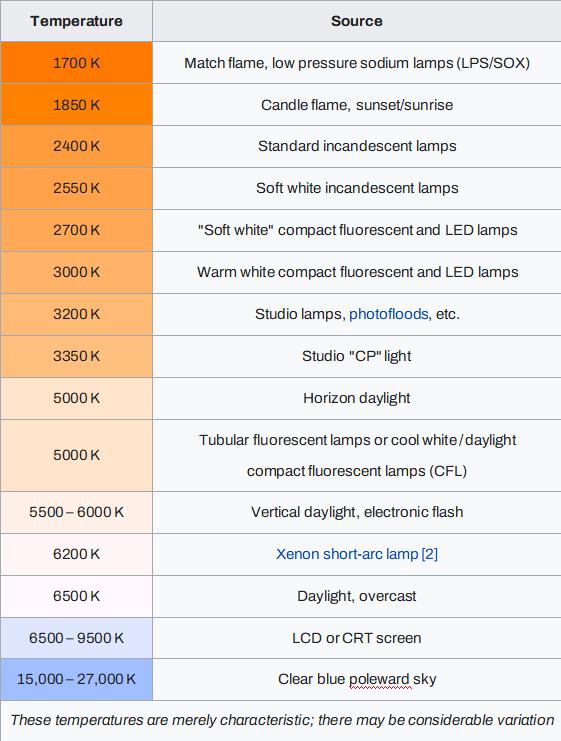
|
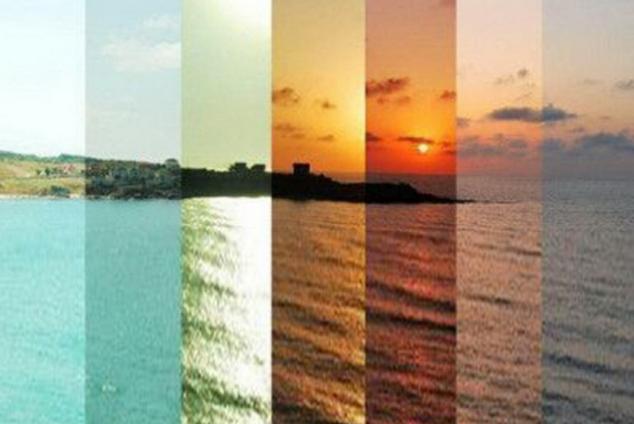
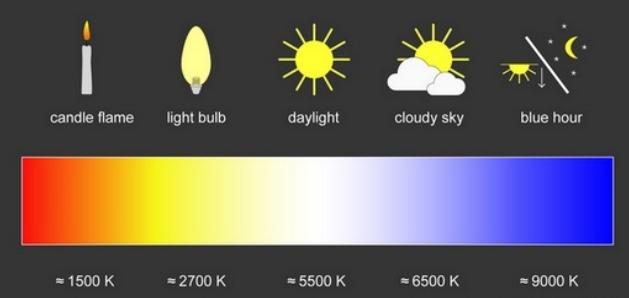
|
Because this is a time-inverse standard compared with other light sources, the color temperature of a black body radiator is equal to the Kelvin temperature on its surface, using a temperature scale named after the 19th century British physicist William Thomson, the first Baron Kelvin .
An incandescent lamp is very close to a black body radiator. However, many other light sources, such as fluorescent lamps, do not radiate energy according to the emission curve of a black body, so they are often associated with Correlated Color Temperature (CCT), which is the way to find the perceived color temperature of a light source that is closest to that of a black body. Because the incandescent lamp does not need this kind of treatment, the CCT of the incandescent lamp is actually quite simple, that is, its unadjusted Kelvin temperature scale, like a heated black body radiator.
Depending on where the sun moves in the sky, the color of the sun will change to red, orange, yellow, and white. During the day, the change in the color of sunlight is mainly caused by the reflection of the atmosphere. In more general terms: the light has been changed and has nothing to do with black body radiation.
Since the natural light source in the daytime has a higher color temperature, and the natural light source in the dusk has a low color temperature, the human brain will be more energetic under high color temperature lighting, but under low color temperature lighting, it will think that it is time to sleep; lighting color temperature It is advisable to adjust the height according to the time.
Even when the sun is only a little higher than the horizon, its effective temperature can be calculated by estimating its apparent color temperature (the apparent color temperature will change according to atmospheric conditions). Therefore, even if the sun looks red and the apparent color temperature is 2500K at this time, a simple calculation can prove that its actual effective temperature is about 5770K.
The blue of the sky is not because of black body radiation, but because of atmospheric Rayleigh scattering that will "break up" sunlight. Blue light is more easily disturbed by the atmosphere than red light. This phenomenon has nothing to do with the characteristics of black bodies.
Color temperature
The color of the light source is often represented by the concept of color temperature. When the color of the light emitted by the light source is the same as that of the black body at a certain temperature, the temperature of the black body is called the color temperature of the light source. In black body radiation, with different temperatures, the color of light varies, and the black body presents a gradual process from red to orange red to yellow to yellow white to white to blue and white. When the color of light emitted by a light source looks the same as the light color emitted by a black body at a certain temperature, the temperature of the black body is called the color temperature of the light source. The higher the temperature of the "black body", the more blue components in the spectrum, and the less red components. For example, the light color of an incandescent lamp is warm white, and its color temperature is expressed as 2700K, while the color temperature of a daylight fluorescent lamp is expressed as 6000K.
For some discharge light sources, the color of light emitted by it is not exactly the same as the color of light emitted by a black body at various temperatures. So in this case the concept of "correlated color temperature" is used. When the color of the light emitted by the light source is closest to the color of the light emitted by the black body at a certain temperature, the temperature of the black body is called the correlated color temperature of the light source.
The color temperature of the light source is different, the light color is also different, and the feeling is different:
| <3000K | Warm (reddish white) steady and warm | Warm (reddish white) steady and warm |
| 3000-5000K | Middle (white) | readily |
| >5000K | Cool type (white with blue) | cold |
Color temperature and brightness: illuminated by a high color temperature light source, if the brightness is not high, it will give people a cold atmosphere; illuminated by a low color temperature light source, the brightness will be too high to give people a sultry feeling. Contrast of light color: using two light sources with large light color difference in the same space, the contrast will have a gradation effect. When the light color contrast is large, the brightness level can be obtained while the light color level is obtained.
Principle
Kelvin believes that assuming that a pure black object can absorb all the heat falling on it without loss, and at the same time can release all the energy generated by the heat in the form of "light", it will produce the highest intensity of radiation. The wavelength changes with temperature.
For example, when the heat received by a black body is equivalent to 500-550°C, it will become dark red (the radiation intensity of a certain red wavelength is the largest), and when it reaches 1050-1150°C, it will become yellow... Therefore, the color composition of the light source It corresponds to the temperature experienced by the black body.
Color temperature is usually expressed in Kelvin temperature (K) rather than in Celsius temperature units. During the ironing process, the black iron gradually turns red at the furnace temperature. This is the best example of the black body theory. Usually the tungsten wire in the bulb we use is equivalent to this black body. The color temperature calculation method is based on the above principle, using K to correspond to the color of the maximum wavelength when the object is radiated at a specific temperature.
According to this principle, the color temperature of any light is equivalent to the "temperature" experienced when the black body emits the same color. Color is actually a psychophysical function. All color impressions are produced due to the intermittent spectrum of the eye's response, so color temperature is only used to express the visual impression of color.
Effect
Some people think that the preference for color temperature is determined by people. This is related to the scenery we see daily. For example, people who are close to the equator usually see an average color temperature of 11000K (8000K (dusk) ~ 17000K (noon)). , So they prefer high color temperature (it looks more real); on the contrary, people in higher latitude areas (average color temperature is about 6000K) prefer low color temperature (5600K or 6500K). That is to say, if you use a high color temperature TV to show the Arctic scenery, it will look blue; on the contrary, if you use a low color temperature TV to watch the subtropical style, it will feel a little reddish.
The above statement is a very common misunderstanding. Normal people of different races and races on the earth have the same feeling of color. Don't think that the colors of the regions or irises are different. There will be differences in the colors you see. Imagine that there are different races from all over the world in the United States. If everyone’s perception of the same color is different, then why have you never heard that movies, TV shows, and magazines will receive complaints from different races of different color casts? Woolen cloth? This in turn also proves that everyone should see the same color (except for color blindness). See "Video Demystified" and "D65, the correct color world you didn't know" for details.
Judging display performance
We know that the light normally seen by the human eye is composed of the superposition of the spectra of seven colors. But some of the light is bluish, and some are reddish. Color temperature is a method specifically used to measure and calculate the color composition of light. It was founded by British physicist Lord Kelvin at the end of the 19th century. He developed a set of color temperatures. The calculation method, and its specific standard is based on the wavelength emitted by a black body radiator.
Color Temperature (ColorTemperature) is a performance indicator of high-end displays. We know that when a light source emits light, it will produce a set of spectra, and a certain temperature that a pure black body needs to reach to produce the same spectrum is the color temperature of the light source. Numerical control monitors above 15 inches must have a color temperature adjustment function. Through this function (generally there are three choices of 9300K, 6500K, and 5000K), the color of the display can meet the requirements of high standard work. Some high-end products also support linear adjustment of color temperature.
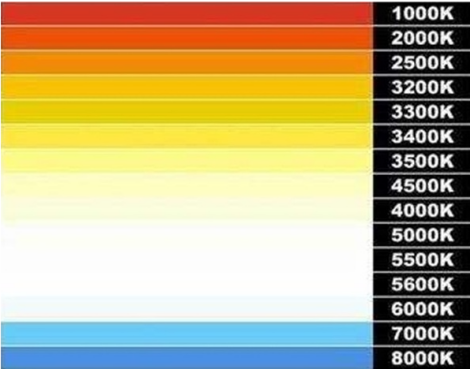
|
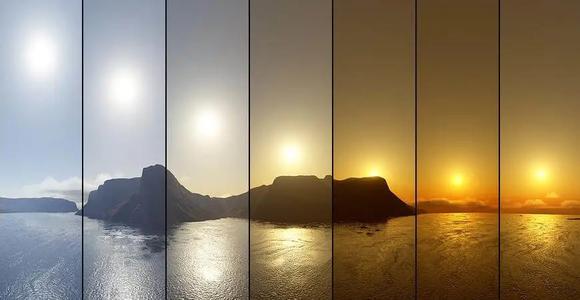
|
Example
The design of color film is generally based on the light source that can truly record a specific color temperature. It is divided into 5500K daylight type, 3400K strong light type and 3200K tungsten lamp type. Therefore, photographers must know how to use color film with the same color temperature as the light source to get accurate color reproduction. If the color temperature of the light source and the color temperature of the film are not balanced with each other, the filter must be used to increase or decrease the color temperature of the light source to match the color temperature of the film to achieve accurate color reproduction.
Generally, two types of filters are used to balance the color temperature. One is the 81 series filter with red color, and the other is the 82 series filter with bluish color. The former is used when the light is too blue (that is, when the color temperature is too high): the latter is used to deal with red light to increase the color temperature. The 82 series of filters are less likely to be used than the 81 series. In fact, the experience of many photographers is to increase the color temperature as much as possible instead of lowering it. Shooting the most common sunset phenomenon with a yellowish filter will produce an extremely spectacular effect.
The experience of an American photographer is that the red filter can reduce the color temperature when the color temperature is as high as 8000K, and the blue filter can make the daylight film suitable for the color temperature as low as 4400K. Usually, by using these filters, you can shoot at almost any time during the day and get natural tones. However, in exceptional cases, when the color temperature exceeds this range, a color conversion filter is required, such as an amber 85B filter, which can make the color temperature up to 19000K suitable for daylight film. On the contrary, the use of light-type film with 82 series filters can reduce the color temperature to 2800K.
If you need to use daylight-type film to shoot under the conditions of tungsten lighting, you can also use an 80 filter. If the TTL exposure meter is not used for light metering at that time, a 2-stop aperture must be increased to compensate for the loss of light. When shooting with light-type film under daylight conditions, an 85B filter is required, and the aperture needs to be increased by 2/3.
However, the common filter codes on the market are very confusing and difficult to identify. Not all manufacturers use standard codes and designs. Therefore, it is not easy to select a suitable filter among many filters. In order to systematize the chaos of filter classification and simplify the selection of filters, Canadian photographer Schwartz introduced a new method of calibrating the color temperature of the light source, which is popular in the world.
Color temperature positioning
How to accurately locate the color temperature? This requires the use of a "color temperature meter".
Under normal circumstances, from 10 noon to 2 pm, the sky is clear and cloudless. When there is no direct sunlight, the standard daylight is about 5200~5500K; the color temperature of the news photography lamp is 3200K; general tungsten lamps, photo studios The color temperature of the tungsten filament lamp used to take black-and-white photos and ordinary ordinary light bulbs is about 2800K; due to the low color temperature, the photos taken in this case will feel yellowish after being enlarged. The color temperature of the general fluorescent lamp is about 7200~8500K, so the photos taken under the fluorescent lamp will be blue.
This is all because the color temperature of the shooting environment is not right with the color temperature set by the shooting machine. Generally, it can be adjusted on the enlarging machine. But if there are fluorescent lamps and tungsten lamps in the shooting scene, we call it a mixed light source. This kind of film is difficult to adjust.
In summary, it is very important to consider, set and adjust the color temperature during shooting. Whether you are using a traditional camera or a digital camera and camcorder. All must pay attention to color temperature!

Effect
Color temperature is a physical quantity used to define the color of a light source in illumination optics. That is, when a black body is heated to a temperature and the color of its emitted light is the same as the color of light emitted by a certain light source, the heating temperature of this black body is called the color temperature of the light source, referred to as color temperature, and the unit is expressed by K .
The light with low color temperature is yellowish, such as incandescent lamp, about 2800K, and the light with high color temperature is blue, such as purple lamp, above 9000K. It is generally believed that the color temperature of standard white light is 6500K, and the white light emitted by CRT is about 5500K. Therefore, by slightly changing the mixing ratio of the three primary colors, you can simulate the effect of increasing or decreasing the color temperature, and use the principle of color temperature to achieve photography, video recording, display, etc. The process of device change is called the color temperature effect.
Balance
In the shooting of film and television lenses, two or more light sources are commonly used for lighting, and under normal circumstances, the color temperature is required to be consistent. In outdoor or real scene shooting, when daylight lighting is the mainstay, lights are often used as auxiliary rib lights. If low color temperature lamps (3200K) are used, the color temperature of daylight (5600K) should be adjusted. The common method is to use Light paper with increased color temperature or direct use of high color temperature lamps, or sometimes deliberately use two color temperature lights to illuminate the same scene separately, without balancing, in order to achieve a warm and cold lighting effect.
The color temperature coordination relationship between light source, color film and camera: daylight film can only be shot under 5600K color temperature conditions; light film can only be shot under 3200K color temperature conditions. Video shooting in daylight plus 5600K color filter, shooting under 3200K light plus 3200K color filter.
Camera fill light
Video fill light is also called video light, headlight, news light, etc. Its main function is to provide auxiliary light when shooting under the condition of lack of light, so as to obtain reasonable picture material. The camera fill light has excellent control performance such as adjusting the brightness, color temperature, and displaying the remaining power.
The previous camera fill light used halogen bulbs and was connected to the mains. Has now been eliminated.
Most of the LED lights are used. Because of its high light efficiency, low voltage, small size, long life, fast response, strong shock resistance, energy saving, environmental protection and other characteristics, it is rapidly popularized.
The new generation of camera fill light uses LED light-emitting diodes as the light-emitting body and uses rechargeable batteries for power supply. Some also use external mains power supply.
The LED camera fill light is divided into high-power LED lights and low-power LED lights, as well as single-color lights and RGB multi-color lights.
The mainstream camera fill light is mostly low-power camera fill light. The camera fill light generally includes accessories such as a lamp body and a diffuser, a battery, a charger, and an adapter rod.
For example, VLOGLITE's W64RGB (pictured below) camera fill light is a low-power RGB multi-color LED camera fill light.
Award
Regarding the interpretation of color temperature and how to use color temperature to shoot excellent works in photography, I hope that readers will share their valuable experience, attach the work, and get 20 likes (this can be this blog post, or repost this blog post to their respective social media accounts) ), we will reward you with 1 VLOGLITE product for your excellent performance and sharing spirit (free express fee).
About the author
Gary zhang is a senior product engineer in the Vloglite team and always actively shares his thoughts on Vloglite. Gary enthusiastically dives into the depths of the photography fill light industry every day, waiting to share new and cool things with you and the vloglite team, so that you can get rich and practical photography fill light knowledge in a happy reading experience and help you keep it. Move your own scene, enjoy a sunny and beautiful life in a beautiful natural environment, and discover a more beautiful yourself.
 +86 13714842239
+86 13714842239



